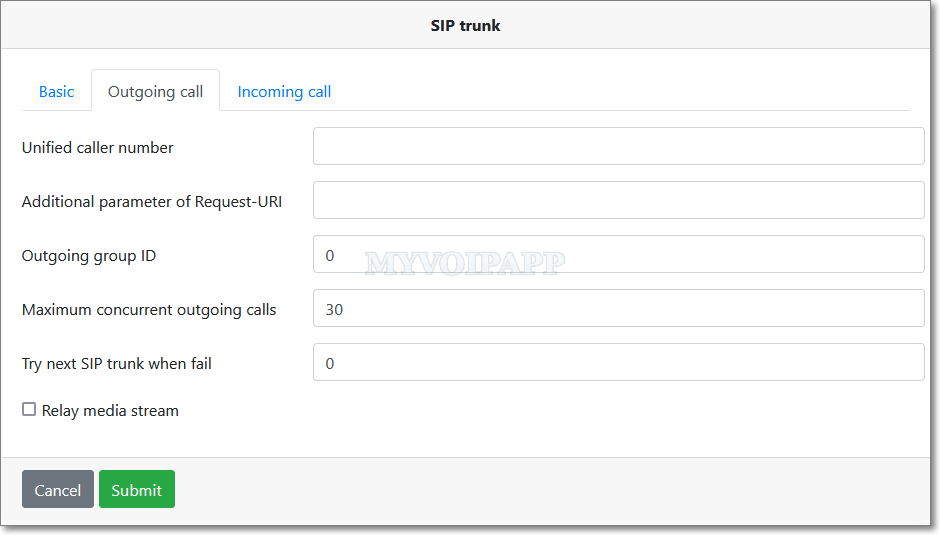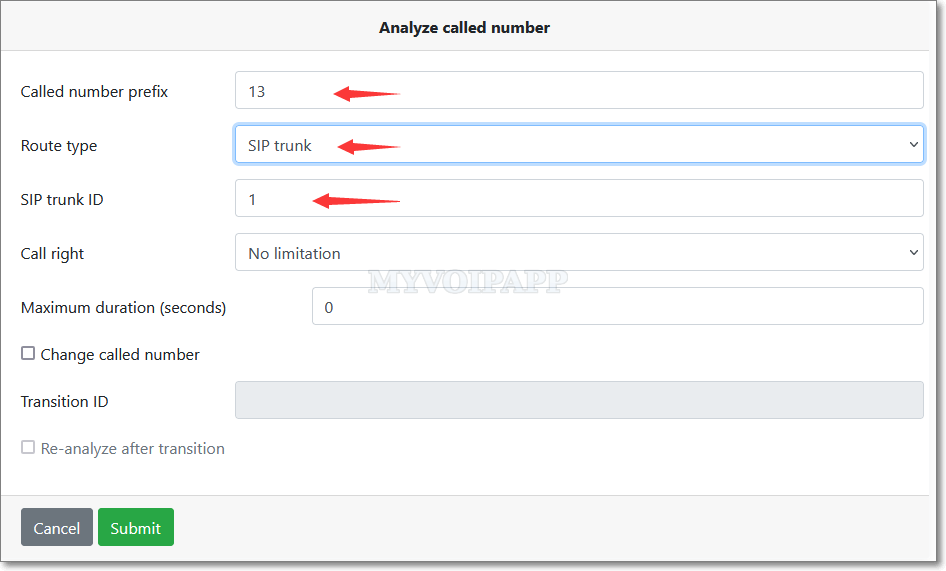"SIP trunk" is used to establish SIP connection between SIP servers, it is a "server-to-server" connection. For example, we can use "SIP trunk" to connect VoIP carriers' servers.

In normal, there are two kinds of SIP trunk:
One is required account and password for authorization. In miniSIPServer, we can configure "external line" to work with it.
Another is IP address authorization. That means each server should know IP address of peer side and trust SIP messages from it. This document is focus on this kind of trunk.
Cloud miniSIPServer can support SIP over UDP and SIP over TLS, but if deploying SIP trunks, it can only support SIP over UDP.
Virtual miniSIPServer node has an independent domain name, we can get its IP address directly. Please pay attention that the IP address is shared with other nodes. But each node has an independent UDP port, so it is no problem to use "IP address + UDP port" to work with SIP trunks.
Please click menu "Data / System", then click "SIP" tab to get the address and UDP port of the virtual server:

3.1 Basic
By default, miniSIPServer will reject all incoming calls if they are not from trusted domains, so we need configure peer IP address into miniSIPServer, then miniSIPServer can trust SIP calls from such address.
Please click menu 'Data / SIP trunk' to get its details. Following figure illustrate "SIP trunk" with a VoIP gateway.

In this configuration, the most important items are "server address" and "server port". miniSIPServer will trust such VoIP gateway and accept all its calls.
| Item | Type or value | Description |
|---|---|---|
| SIP trunk ID | Integer | ID of current record. |
| Server address | String | Peer SIP server IP address. It cannot be blank. |
| Server port | Integer | Peer SIP server IP port. It cannot be blank. |
3.2 Outgoing call

| Item | Type or value | Description |
|---|---|---|
| Unified caller number | String | It can be blank. If it is not blank, miniSIPServer will use it as caller party number in the outgoing calls. |
| Additional parameter of Request-URI | String | It can be blank. If it is not blank, miniSIPServer will add it to the Request-URI of all outgoing calls. |
| Outgoing group ID | Integer (>=0) | In "dial plan" process, it can use this group ID to refine the final called number when sending the call out. Default "0" means there isn't group and "dial plan" process will not refine its numbers of outgoing calls. |
| Maximum concurrent outgoing calls | Integer (>=0) | The maximum concurrent outgoing calls of the SIP trunk. Too much outgoing calls will be rejected. If it is zero, that means no outgoing call. The SIP trunk will only be able to receive calls, cannot make calls out. |
| Try next SIP trunk when fail | Integer (>=0) | Next SIP trunk ID which will be called to if current call is failed. If it is zero, the call will not try another SIP trunk and be released directly if it is failed. |
| Relay media stream | Yes or no | By default, SIP trunk will not relay media stream in outgoing calls. If this item is selected, SIP trunk will relay media streams for its outgoing calls. At this time, only audio streams will be processed. |
| Use the tel URI | Yes or no | By default, miniSIPServer always uses SIP URI format, for example,<sip: user@minisipserver.com>. If this item is selected, miniSIPServer will uses the tel URI to send out calls, for example, <tel:1234>. |
3.3 Incoming call

| Item | Type or value | Description |
|---|---|---|
| Maximum concurrent incoming calls | Integer (>=0) | The maximum concurrent incoming calls of the SIP trunk. Too much incoming calls will be rejected. If it is zero, that means no incoming call. The SIP trunk will only be able to make calls out, cannot receive any calls from outsides. |
3.4 Dial plan
Sometimes, we hope to make calls to outside users through SIP trunk. For example, we have a VoIP gateway connected with PSTN network, and we hope to dial "13xxxx" to make calls to outsides PSTN lines or mobile phones.
Please click menu 'Dial plan / Analyze called number' to add a record.

In this configuration, the 'route type' is 'SIP trunk' and 'SIP trunk ID' is configured at above section. With this configuration, when dial '13xxxx', the call will be routed to VoIP gateway whose IP address is '8.8.8.8'.
Please refer to "Dial plan" feature for more details.
Q1: My VoIP provider has several servers,what should I do?
Well, you can add all their IP addresses into 'Data / SIP trunk' configuration. Then, you can configure 'routing group' feature to use them.